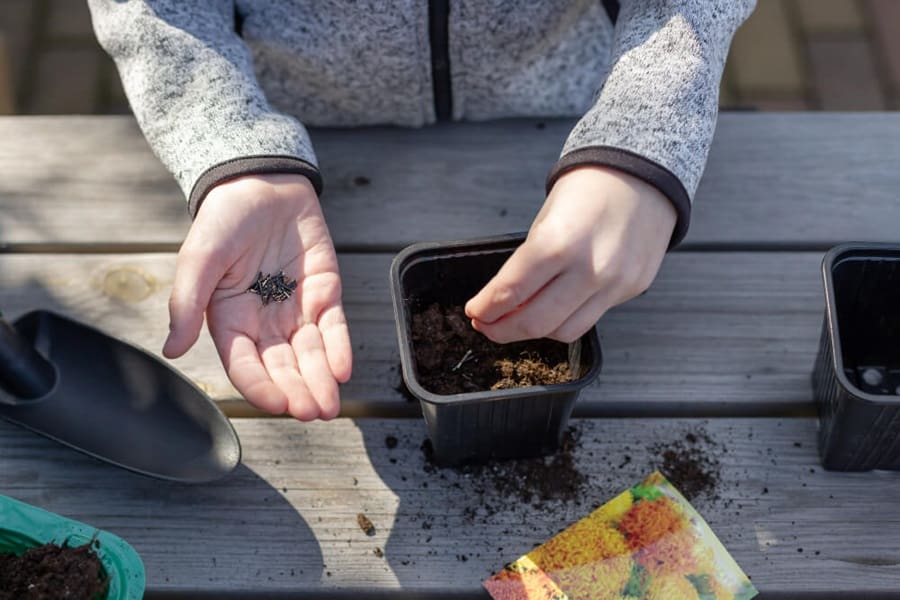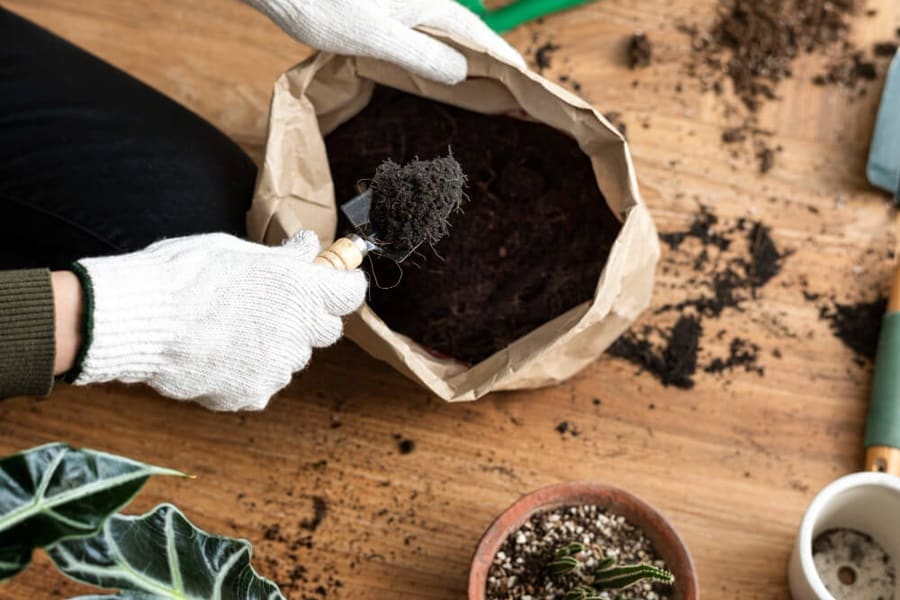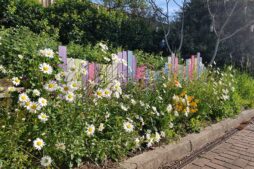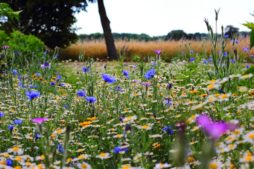Food scraps and yard waste should never be discarded. It’s what’s essentially referred to as “black gold” as it has so many benefits, including improving the quality of your soil and providing plants with the nutrients they need to flourish.
Making compost is easy when you know where to start. If you’re wondering how to make compost at home, then this in-depth guide is all you need.
- Quick facts about compost
Quick facts about compost
- Always use ‘green’ waste when you make your own compost. This includes veg peelings, annual weeds, and leafy debris.
- Many people learning how to compost understand that adding ‘brown’ waste like cardboard and shredded woody prunings is very effective.
- Keep the size/layout of your space and the amount of waste in mind, so that you can decide whether your compost bins should be large or small.
- Go with a shady and sheltered spot for your compost bin. Place it directly on the soil if possible.
How To Make Compost At Home: Tools Needed
- A sunny corner of your garden
- Waste rich in a 50/50 mix of nitrogen and carbon
- A compost bin
Making Compost: Why Make Your Own Compost At Home?

Never let garden waste go to waste
Your garden waste isn’t actually ‘waste’ and here’s why:
Everything from hedge-trimmings and faded flowers to annual weeds, lawn clippings and even kitchen waste like paper and veg peelings, are quality nutrition for your soil!
Now, these can always be recycled in your locally designated waste collection, but why not reap the benefits for yourself by beautifying your garden?
Home composting adds valuable organic matter to your soil – matter which improves its aeration, structure, and biodiversity. It even helps your soil retain moisture and slow down the process of evaporation during summers.
All in all, making compost at home is fantastic for your garden’s biodiversity. Multiple kinds of fungi and microorganisms in the soil thrive, while woodlice, slugs, worms, and other invertebrates feed on the decaying material – thus, providing food for toads, hedgehogs, birds, and other precious wildlife. You’re doing a favour to both your garden and the environment as well as the ecosystem on a whole!
4 Key Benefits of Composting
1. Manipulates and improves the soil’s pH level
Compost is great for naturally neutralising the soil. What this means is that it absorbs the ions in the soil to either increase the PH of acidic soil or reduce the PH of alkaline soil.
Not only that, but composting can help you manipulate your soil’s PH level, making it more or less acidic. So, if you’re growing plants that require high acidity in the soil (or high alkalinity), then compost is your friend!
2. Improves the soil’s structure
Compost has organisms which help to break up the soil. When small gaps are created, air flows more freely into the soil. The organism also help to bind clay, soil and silt particles – a process known as aggregation.
This is what gives the soil its typical dark and rich tone as well as crumbly consistency. Soil aggregation is actually a very good indicator of the overall quality and health of your soil.
3. Increases plant growth and reduces fatality
As discussed earlier, compost contains the vital nutrients plants need to thrive. As a result, plants develop more extensively, with stronger and healthier root networks.
Plants grown in compost also become capable of detecting and fighting diseases – so in a way, you’re strengthening your plants’ immune system!
4. Manage garden pests
While insect spray is a common method of keeping garden pests at bay, the chemicals in it can have a very detrimental effect on whatever you’re trying to grow.
Garden compost contains micronutrients which function more or less the same way as a commercially available pesticide, thus, reducing the need to douse your garden with chemicals and sprays.
Types of Composting

Before you learn how to make compost, it pays to quickly understand the three key types of home composting:
Cold compost
Cold composting refers to collecting yard waste or taking out organic materials like eggshells, fruit & veggie peels, and coffee grounds, for instance, from your trash and corralling them in a bin. In about a year or so, everything will decompose, giving you fresh compost.
Hot compost
Hot composting actually requires a little bit of work, although the key advantage over cold composting is that it’s much faster – in the warm months, you can expect to get compost in about 1-3 months.
You’ll need four key ingredients for this: carbon, water, nitrogen, and air. When combined, these feed microorganisms, hence, speeding up the decay process. There will be plenty of garden waste during the growing season, so go ahead and mix a big batch of compost while you start a second one, because the first one is “cooking” nicely!
Vermicomposting
Vermicompost can be made by using worms. When you let these worms loose on your food scraps, they release nitrogen-rich castings. However, you need to use red worms only, otherwise known as “red wigglers”. These can be purchased at any online store selling garden accessories.
Home composting: What to compost?
To make your own compost at home, you can use many items from your fridge and garden that are no longer edible, have expired, or not needed (waste).
Ideal composting materials
This will not only reduce food waste but also provide you with the ‘fuel’ for making compost at home:
- Fruit and vegetable scraps/peels
- Eggshells (they’ll take longer than the other listed items to break down)
- Coffee grounds
- Dry leaves
- Grass and plant clippings
- Sawdust from untreated wood
- Shredded newspaper
- Hedge trimmings
- Prunings
- Paper towels and bags
- Wood and bark chips (finely chopped only)
- Straw
- Teabags
- Cardboard
- Annual weeds
- Hair and fur
Materials to avoid
Some items to avoid when we talk about how to make compost at home:
- Dairy
- Cheese
- Pet waste (cat and dog faeces, specifically)
- Fats and oils
- Meat scraps
- Cooked food
- Autumn leaves
- Citrusy foods
- Perennial weeds
- Diseased plants
- Chemically treated wood
These are best avoided as they can not only cause nasty odours but also contain harmful chemicals and/or diseases.
Composting at home: Everything you need to know
How to make compost at home can be really easy once you understand the various ways involved:
Kitchen composting
A composting container in the kitchen is a great way to accumulate the raw materials for your compost while preparing meals. Alternatively, you can make an indoor or outdoor compost bin, although kitchen scraps can start spoiling quickly, so you should store them in your freezer until they can be placed outside in the larger pile.
Making hot compost
Making your hot compost heap at home means having enough raw materials to make a pile that’s at least 3ft deep. Use a combination of wet greens and browns.
So, greens essentially contain coffee grounds, kitchen scraps, and animal faeces (not from cats and dogs) as well as grass trimmings and fresh plant – that’s your nitrogen mix.
Browns contain wood shavings, cardboard, straw, hay, newspaper, fallen leaves, dried plant materials, etc. – that’s your carbon mix.
It’s best to start building your home hot compost in a three parts brown materials, one part green material mix. However, if it looks too wet and smells nasty, just add more brown. If you end up making it too brown and dry, add more green and add a little water to moisten it.
Watering compost pile
When watering your compost pile, keep this simple rule in mind: the compost needs to have the consistency of a damp sponge.
Just don’t add too much water, though, because you don’t want to waterlog and drown those precious microorganisms, causing the entire pile to rot. Monitor the temperature of your pile to ensure that it is decomposing optimally – it should feel warm to the touch as you reach into the middle.
Stirring compost pile
Turn or flip your compost pile once a week during growing season using a fork or specialised garden tool.
Place a thermometer in the middle of the pile – if it reads between 54°C and 65°C, then turn it. Stirring your pile will help it cook faster and prevent the materials from being matted down as this can cause an odour.
Feeding garden with compost
At one point, your compost will stop giving off heat and become dry. It’ll look brown and crumbly which means it’s fully cooked and now ready to be used in your garden.
Add around 4-6 inches of compost to each flower bed along with a thick layer to the top of each pot as planting season begins. On a side note, you may be interested in low maintenance plants for pots and best spring bedding plants, so it’s worth reading up on!
You can even make compost tea with finished compost – just allow the fully formed compost to “steep” in the water for a couple of days (just like you do with tea) and then strain it to be used as a liquid fertiliser at home.
Starting a compost bin
A new compost bin can be started at practically any time of the year, although it’s best to start when your garden is producing a lot of the ideal raw materials – so, this would be from spring onwards.
Making compost in a bin is almost always easier, tidier, and quicker. Handpick a compost bin size, according to the available space and the quantity of waste your garden can produce. A compact plastic bin, for example, is a great choice for a small garden, especially if you’re a beginner composting at home.
For a relatively larger garden area, you may want to use a wooden compost bay, like one made from pallets, for instance.
Stand your compost bin directly on a soil base to allow soil organisms easy access and for easy drainage.
Make Your Own Compost At Home
Ultimately, you’d want to choose a home composting method that fits your lifestyle and the type of garden you have. Now that you know how to make compost, go ahead and give that lovely garden of yours a treat!
FAQs
What is the best way to make your own compost?
Combine green (nitrogen-rich) and brown (carbon-rich) materials in a 1:3 ratio.
Maintain moisture like a wrung-out sponge.
Turn the pile regularly to aerate.
Use a compost bin to manage temperature and pests.
How do you compost for beginners?
Start with a simple compost bin.
Add equal layers of green and brown materials.
Keep the compost moist, but not wet.
Turn the pile every few weeks to aerate.
What is the fastest way to make compost?
Use hot composting method.
Maintain a good balance of green and brown materials.
Ensure adequate moisture and aeration.
Turn the pile frequently to speed up decomposition.
Sources
Perling, A., Okatomo, K., (2023) Kitchen Compost Bins We Love. Wirecutter. [online] Available at: https://www.nytimes.com/wirecutter/reviews/best-compost-bins/ [accessed 21/12/23]
Ryan Jenkins is a professional gardener and has been working in the gardening industry for over 25 years. This has allowed Ryan to accumulate a vast wealth of gardening knowledge which he shares on the Sefton Meadows blog.




